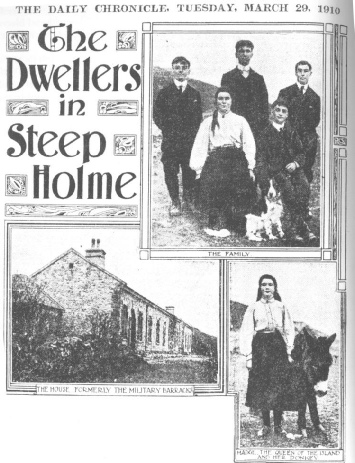

But at the end of 1912, they left the island and moved to Eastington to help their father and brothers run the business in Millend Mill. This had been bought by James snr. in 1910 along with 16 cottages (Millend Row) and a bakery. The intention was for at least some of the family to return to the island in the spring, but most stayed in Eastington, including Madge who acted as housekeeper, now looking after her brothers and ageing father. The outbreak of the First World War made life on Steep Holm more difficult as it was partially requisitioned by the Admiralty for the duration of the war.
Madge’s life in Eastington
Madge worked as housekeeper and also helped run the mill. Later, as her father’s health deteriorated, she also became his nurse. As the press reporters had noticed (and confirmed by villagers) her greatest love was for birds and animals -
Villagers remembered that young blackbirds fallen from the nest were tamed by her, and perched happily on her shoulders as she cycled around on an old bicycle with her faithful spaniel sitting in a tomato box perched on the back… after the death of her father (in 1938) she extended her nursing care to other people in the village, and she is still remembered with affection by elderly Eastington villagers. As one expressed it: she was kind and well-
‘Queen’ Madge died alone in her Millend Row cottage on 5th January 1996, aged 72. She is buried with her brother Oliver in the village cemetery.
Postscript
In 1998, a social history website carried an email from someone enquiring about the Sleeman family in Gloucestershire. A lady from the Isle of Man (yet another island!) replied that her mother had known a Miss Sleeman during the 1950s. She lived in a little cottage behind the Mill at the bottom of Eastington. She occasionally babysat for her mother’s friend who lived next door. Her mother recalled that Miss Sleeman had told her that when she was a girl, she had lived on a tiny island in the Bristol Channel, near Weston Super Mare. What an amazing coincidence!
Note:
Stan and Joan Rendell’s book Steep Holm Pioneers, was published privately in Weston-
Readers will remember that the Sleeman name has cropped up a few times in previous editions of ECN, all in connection with Millend Mills’ use as a maltings during the early part of the last century. Under the control of the head of the family, James Sleeman, the business operated at Millend until 1937, when bankruptcy finally closed its doors for the last time.
But we’re getting ahead of ourselves – this article is not about James Sleeman and his business activities, it’s about his daughter Madge.
For decades after James’ death in 1938, she became something of a fixture of the village, one of those fascinating eccentrics no longer encountered in daily life. Like her four brothers James jnr, Tom, Oliver and John, she had a most unusual and interesting upbringing, something that undoubtedly influenced the way she approached life and the type of person that she became.
Her story really begins not in Eastington, but in Portishead on the banks of the Bristol Channel, where her father, James snr, was the manager of a newly-
Up to April 1909, Steep Holm had been a military base, under the control of the army. When they vacated the island, they left behind massive guns emplacements, 7-
Surprisingly, James snr. stayed on the mainland, while his five children and a female relative moved to Steep Holm.
Madge had been born in May 1893, so was only around 16 at the time. The intention was that the youngsters would be self-
In April of that year, James snr. moved to Eastington, taking over the empty Millend Mill.
Meanwhile on Steep Holm, life continued for the five young people, with their unusual lifestyle. It was so unusual that it even attracted the attention of the national press.
In March 1910, they were paid a visit by a reporter and photographer from the Daily Chronicle. The reporter noted that:
Madge, a pretty girl in her early teens, bore an air of queenly authority and the reporter had never before seen a more self-

Two years later, in September 1912, John, Oliver and Tom left the island, leaving Madge and her brother James to look after the poultry and goats, as well as the vegetable garden. So now, it was just the two of them plus Madge’s pet spaniel and the old donkey used to carry supplies up from the beach to the barracks.
The press came calling again. This time it was the Daily Mirror. Their article talked about the “Island king and queen – the boy and his sister who lived alone on the little island in the Bristol Channel”.
The reporter wrote :
Queen Madge, a pretty girl in her teens with a beautiful complexion and flowing hair. She discharges her domestic duties admirably with quiet ease and dignity. She is accompanied by her fowls, and her herd of goats adorned with fearsome horns follow her obediently, each answering to its name. Madge is passionately fond of animals, even the donkey, and they all vie with each other for a moment’s companionship. She knows their every whim, what they like and dislike, and when she seats herself on a gun in one of the batteries to enjoy the sunshine, or sweep the seas with a telescope, the goats, the donkey and the Belgian hare wend their way from all parts of the island to form a cordon around their friend and benefactor, each anxiously waiting to be stroked and spoken to.

Stephen Mills
Pubished in ECN 152 Aug/Sept 2015
Queen Madge of Millend
